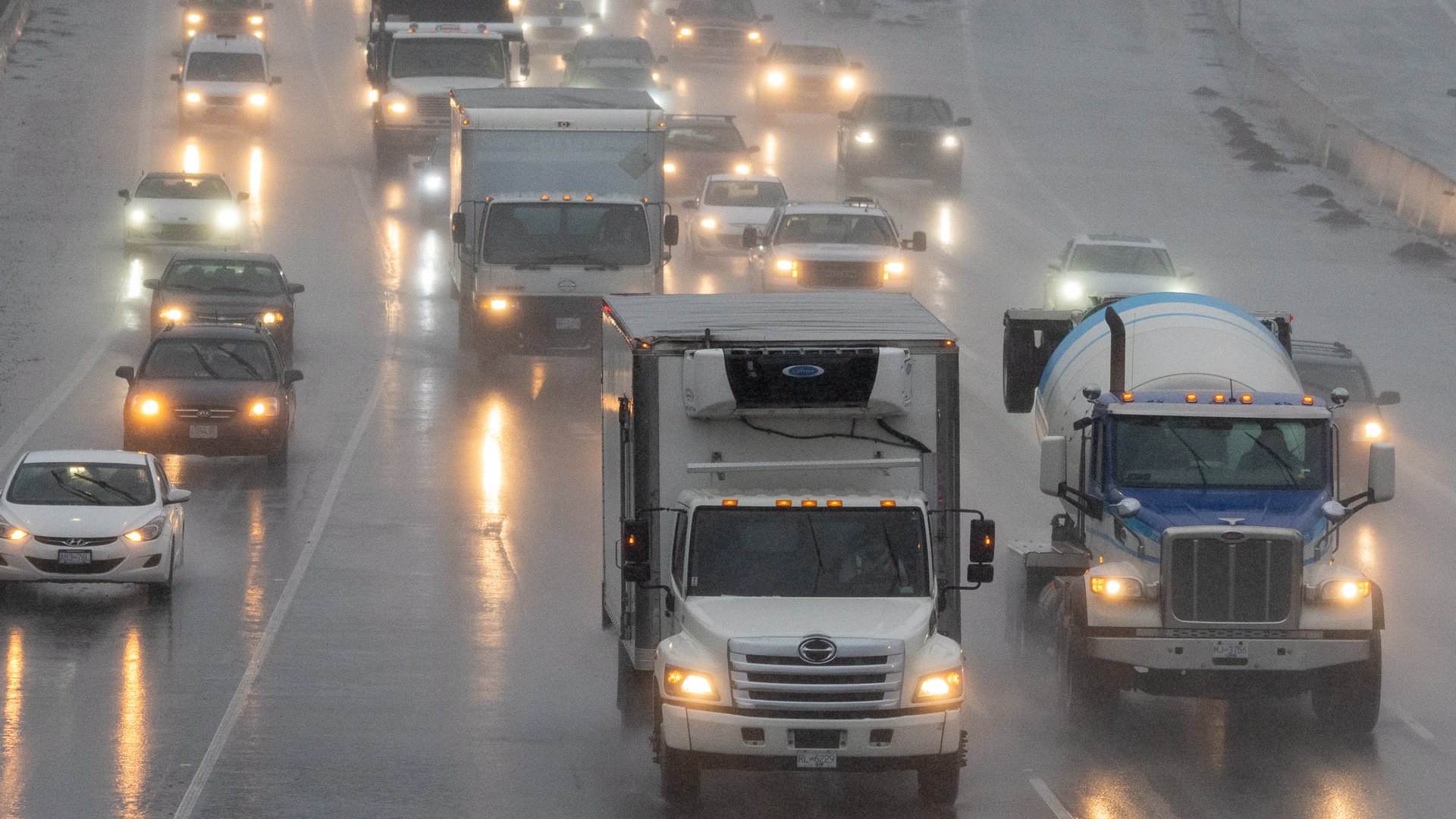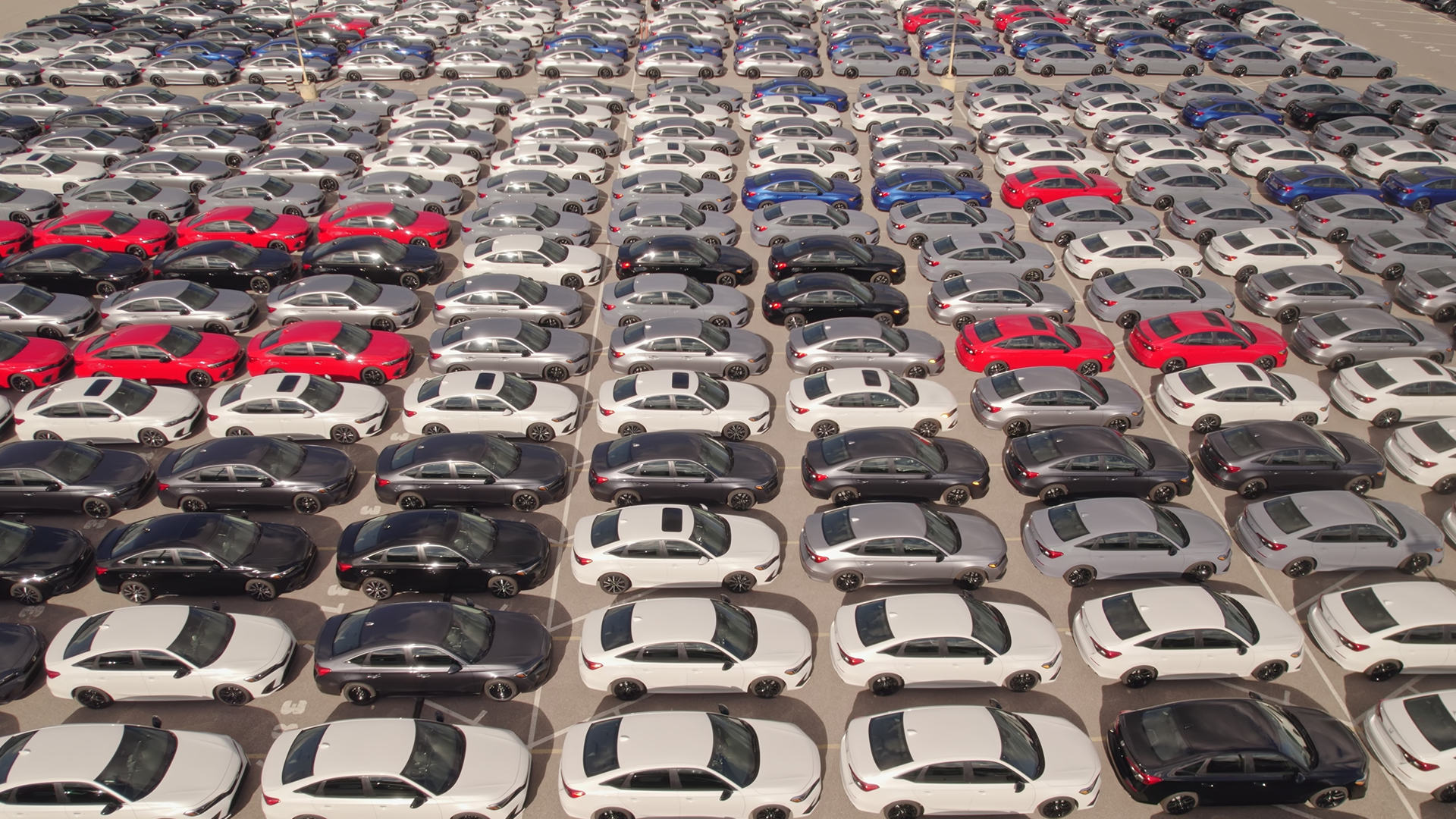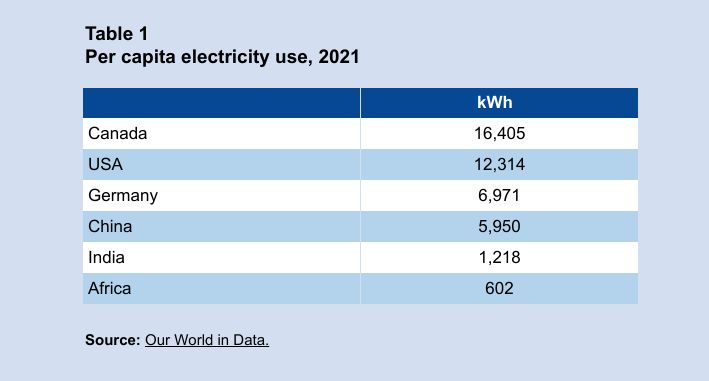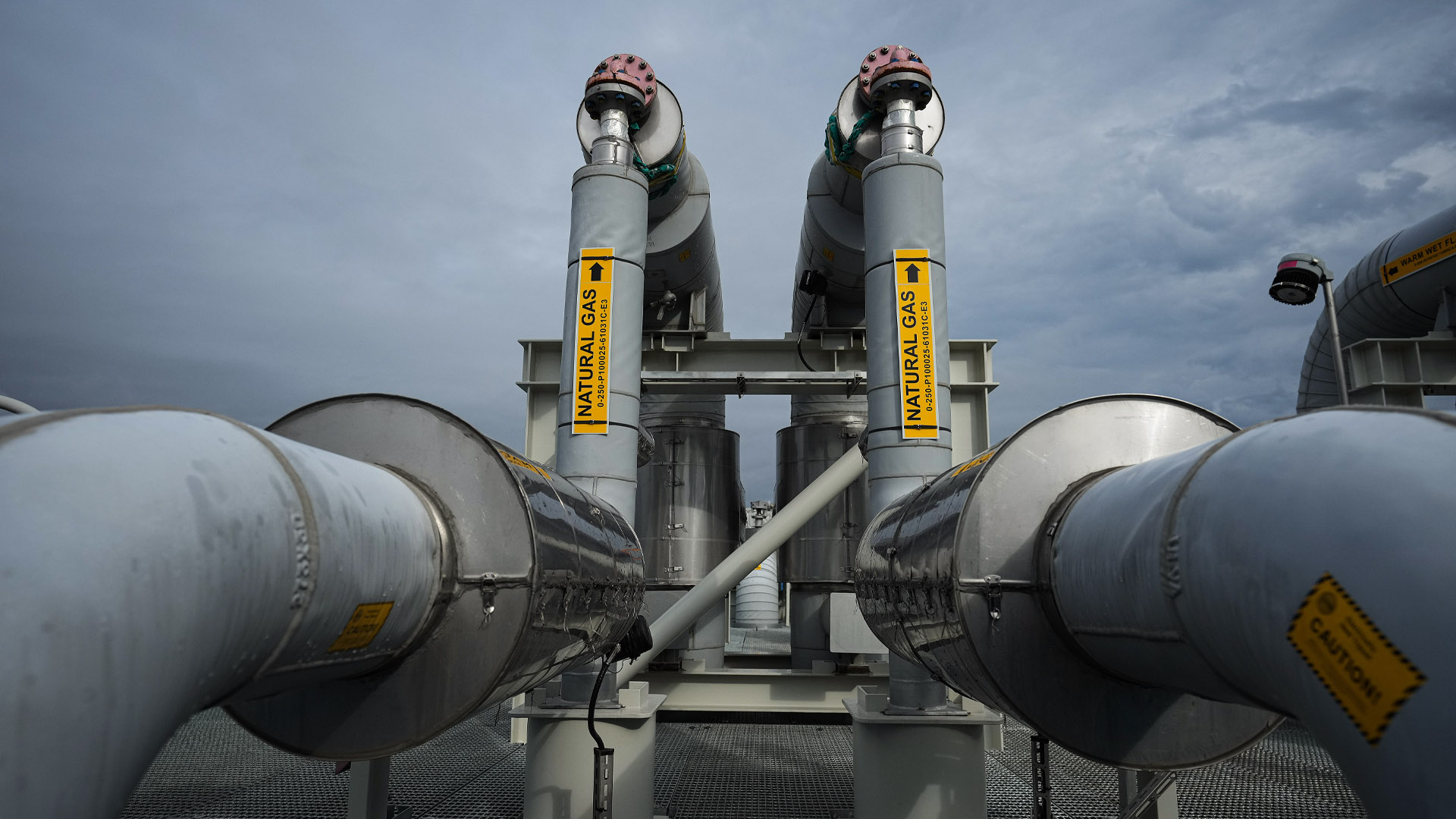
Canada is the world’s largest user of electricity on a per-capita basis. Much of this is due to resource processing and the use of electric resistance heating in jurisdictions with low electricity prices in relation to natural gas (table 1).
Electricity use in OECD countries has been flat for the last five years, but worldwide it is increasing at a rate faster than population growth (figure 1). Most of this growth is due to developing economies, which are increasing both their electricity and total energy use as they modernize and grow.
Approximately 775 million people live without electricity, down from 1.3 billion in 2012, according to the International Energy Agency.
Canada also has one of the lowest carbon electricity systems in the world. As a nation, more than 80 per cent of electricity generation is from non-carbon emitting sources, dominated by hydro (60 per cent) and nuclear (15 per cent), with the rest being supplied by “new renewables” (wind, solar, and biomass, 6.4 per cent), and fossil fuel (natural gas and other, 18.6 per cent).
The generation mix of Canada’s three largest provinces representing 75 per cent of Canada’s population – Ontario, Quebec, and BC – is 90+ per cent zero emitting (table 2).
Economic growth is driving electricity needs in developing economies, but the ability for electricity to be generated from non-carbon sources along with climate-driven decarbonization goals like net-zero by 2050 is now driving increased electrification in developed economies as well.
The strategy is simple: transition traditionally fossil fuel end-uses to electricity, and transition fossil fuel electricity generation of non-carbon sources. The execution is more complicated.
Consider two of the major carbon-emitting end-use transitions being promoted in Canada:
- Internal combustion engine (ICE) vehicles to electric vehicles (EVs).
- Home heating from natural gas to electric heating via heat pumps.
The first battery-driven vehicles (in the 1830s) predated the gas-powered vehicles, and as late as 1915, more than 35 per cent of vehicles in the United States were electric. However, over time as fuel resources and ICE technologies improved, the EV essentially disappeared.
With the recent development of “low-cost” lithium batteries (and some incentives), EVs are again growing in market share. As well, the federal government recently announced planned minimum EV sales requirements, hoping to phase out ICE vehicles by 2035. Other jurisdictions have announced similar targets.
The federal government and some provinces are also considering programs, incentives and building code requirements for the transition to heat pumps for heating.
These two transitions will require significant increases in electricity and material resource demands.
An EV battery, for example, adds about 450 kilograms to the weight of the average car (about a 20 to 30 per cent increase in total vehicle weight) including lithium (11 kg), cobalt (14 kg), nickel (27 kg), copper (40 kg), graphite (50 kg), and 181 kilograms of steel/aluminum/plastic. To supply this requires processing about 40 tons of ores obtained from extracting 225 tons of raw material.
Although lithium and cobalt get a lot of attention, a more basic concern is copper. Electrification needs copper – to generate, transform, distribute, and utilize it. In 2020, worldwide copper production was 20 million tonnes. Chile is the largest producer at (29 per cent), with Peru and China 2nd and 3rd. Canada is the 11th highest producer at 570,000 tonnes (2.9 per cent).
The typical ICE passenger vehicle uses 23 kilograms of copper, according to the International Copper Association. The equivalent EV requires 83 kilograms (battery and motors). An EV truck requires between 200 and 400 kilograms.
Now consider the increase in copper needed for heat pump compressor motors, the electrification growth in developing economies (more motors), and the upgrading of the grid infrastructure to meet the increased electric load.
B.C. will need a mix of direct electrification and renewable natural gas
Ontario’s deepening hydro mess
In July 2022, S&P Global forecast a possible need to double copper production by 2035 to stay on track for net-zero by 2050 in its report “The Future of Copper – Will the Looming Supply Gap Short Circuit the Energy Transition?” That is a growth rate of 5.5 per cent annually – the equivalent of about two new Canadian copper industries per year.
Less lithium is produced: 100,000 tonnes in 2021. Seventy per cent is destined for batteries, with 90 per cent supplied by Australia, Chile, and China. This, however, is a 400 per cent increase from 2010. Converting to passenger EVs would require additional 600 per cent increase from 2021. Converting all vehicles would double this. Grid and building integrated batteries to support intermittent renewable energy would increase this even further.
Electrification is a mining issue, and this raises several concerns.
1. Mining projects take decades from discovery to production due to regulatory burdens.
2. Copper and lithium reserves are concentrated, even more so than fossil fuels.
3. Shortfalls strain supply and raise prices.
Implications for electricity demand and carbon reduction
In Canada, the transition to EVs and heat pumps represents a doubling or tripling of the current electricity supply requirement, all required by 2050 as part of the net zero commitment. So, while this transition may be driven by Canada’s current low carbon electricity mix, the actual effectiveness of this initiative relies on Canada’s future electricity mix.
Take Toronto as an example. Converting just the city’s 650,000 natural gas heated homes to best-in-class heat pumps would bring a demand increase of about 5,000 MW of electricity, doubling the city’s demand. Commercial heating and EVs will drive this increase further.
The new load due to electrification of these two end-uses will therefore require new electricity supply.
Natural gas is often referred to as the transition fuel, significantly reducing carbon in the transition from coal (or oil). If this new electricity requirement is supplied by natural gas generation (55 per cent efficiency), the transition to EVs and heat pumps represents modest progress from a carbon perspective.
Let’s look at a heat pump vs. a natural gas furnace: The coefficient of performance – the ratio showing energy efficiency – of a best-in-class air-source heat pump is approximately 1.8 at minus-20C. That means it provides 1.8 kWh of heat energy per 1 kWh of electric energy used. At 55 per cent generation efficiency, that results in an equivalent combustion efficiency for the heat pump at 99 per cent (1.8 * 1/.55) compared to 98 per cent for the best condensing natural gas furnaces. Bottom line: In warmer outdoor temperatures, the heat pump would do better, but it would be worse in colder temperatures.
How about EVs? A typical mid-size passenger EV uses 0.195 kWh/km and would produce 104.24 g CO2/km (more in winter as mileage is reduced due to the cold). Assuming an average mileage of 8 L/100 km (Honda Accord) and 2.3 kg of CO2 per litre of gasoline, the result is 184 kg/km. This represents a significant savings in mileage CO2, but these are reduced when considering the embedded energy from battery processing.
Timelines are measured in decades
Without new carbon-free electricity generation, electrification and the EV and heat pump heating transition will have little climate impact.
Solar and wind are possible, in theory, but the anticipated electricity demand, the resources required to meet it, and the need for storage or back-up to deal with the 70 or 80 per cent of the time these renewables are not generating rule them out as major contributors. Large hydro is possible if we are willing to dam large areas, re-route rivers and build transmission to deliver this power from the remote locations where the resources are located.
This leaves nuclear power. The last nuclear plant built in Canada was Ontario’s Darlington (4800 MW), which was completed 30 years ago in 1993 – 10 years late and $10 billion over budget. Darlington consists of four 1200 MW nuclear reactors, the largest ever built in Canada. Today’s nuclear generation development is focused on what are called Small Modular Reactors (SMRs) and Ontario is researching and developing a 300 MW system.
In Canada, 5.1 million homes are heated by natural gas. Using the Toronto example results in more than 42,000 MW of new capacity by 2050 to meet this winter home heating demand, more than one Darlington station every three years, or five 300 MW SMRs annually. A recent report by the Independent Electricity System Operator in Ontario titled “Pathways to Decarbonization” suggests that 69,000 MW of non-emitting capacity would be needed in Ontario to meet all its winter electrical demand under similar net-zero by 2050 electrification scenarios.
These transitions, the electrification of end-uses and the growth of a non-carbon electricity supply represent challenges that even an optimist would have problems with.
The industries impacted – electric utilities, auto, HVAC, and natural resources – are large and well-established, with stable and significant material supply chains and processes. Disrupting these to tackle climate change over decades will require significant co-ordination of markets and major investments. They will also require planning, design, permitting and building at a pace significantly faster than is typical in the current political, economic and regulatory environment.










